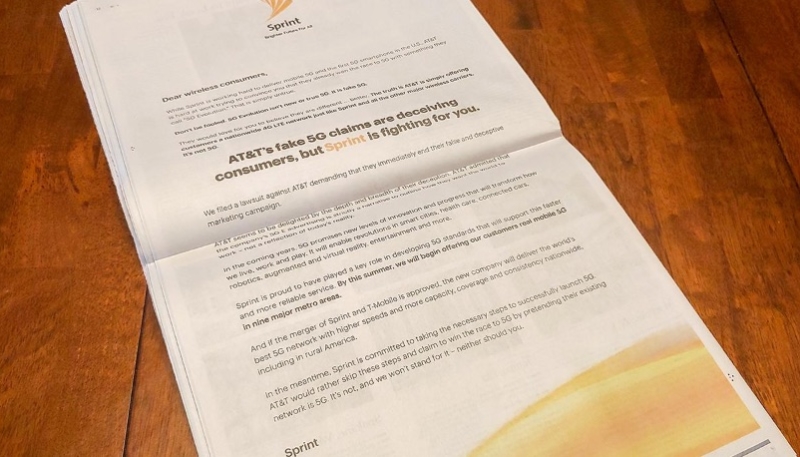Although the Sprint/T-Mobile merger is far from being completed, Sprint is already adapting the bombastic tendencies of T-Mobile’s CEO, John Legere. The number four wireless carrier posted an open letter to consumers calling out AT&T for its “5G Evolution” advertising push, saying the carrier’s “5G E” connectivity branding is intended to mislead consumers.
The letter (PDF link), distributed as a full-page ad in The New York Times on Sunday, is the latest effort from rival U.S. cellular carriers attempting to inform consumers of AT&T’s controversial marketing scheme.
“While Sprint is working hard to deliver mobile 5G and the first 5G smartphone in the U.S., AT&T is hard at work trying to convince you that they already won the race to 5G with something they call ‘5G Evolution.’ That is simply untrue,” the letter reads. “Don’t be fooled. 5G Evolution isn’t new or true 5G. It is fake 5G.”
AT&T’s “5G Evolution” label has been used by the carrier since 2018, and refers to a network currently being deployed across the U.S. and is built on existing LTE technology. The network can hit a theoretical speed of 400Mbps, well below the gigabit speeds promised by actual 5G technology.
In January, AT&T began selling devices that show a “5G E” connection icon when connected to the number two carrier’s upgraded cell towers in areas where the “5G Evolution” equipment has been installed. Competing carriers immediately blasted AT&T for the move, with executives from Verizon and Sprint calling the practice “misleading.”
Sprint’s senior vice president of corporate communications, David Tovar, repeated that claim in a statement this week.
“AT&T is not offering its customers 5G but is delighted by the confusion they’ve caused with their deceptive 5G E’ marketing and attempt to convince consumers that they’ve already won the 5G race,” Tovar said. “We’re not standing for this kind of deception, and neither should consumers. We already filed a lawsuit in federal court asking that AT&T be stopped, and now we’re further exposing AT&T’s false claims. Every carrier – every company – should tell consumers the truth and be held accountable for the promises they make.”
Apple’s iPhone and iPad devices have so far escaped the “5G E” labeling, but will soon receive it when iOS 12.2 is released to the public.
This isn’t the first time AT&T has used misleading labeling for its connections, as they made a similar move during the transition from 3G to 4G LTE, labeling HSPA+ connections as “4G” as a stop-gap measure while they set up their actual 4G network.


